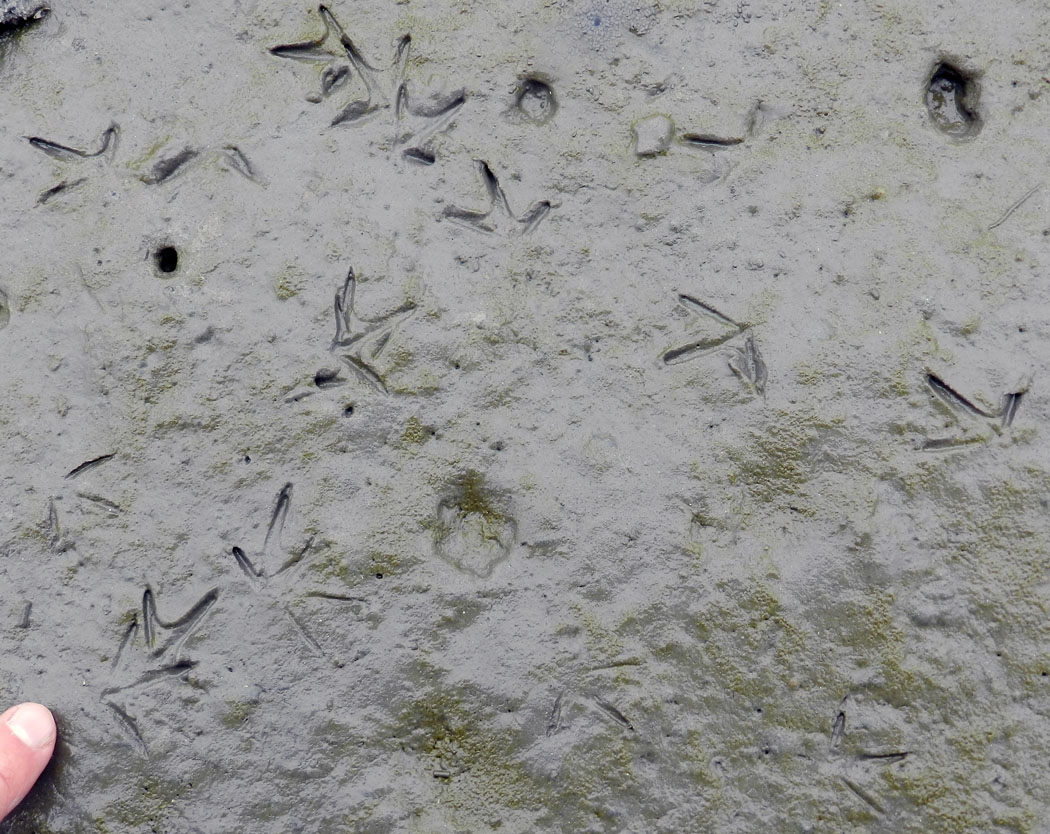As mentioned in yesterday’s post, I will be celebrating the traces of the Georgia barrier islands over a 12-day period approaching the holidays (you know: Winter Solstice, Christmas, Kwanzaa, Boxing Day, and New Year’s). To keep it relatively simple, each post will be about traces from a Georgia barrier island depicted in a single photograph, followed by my pithy descriptions and trenchant analyses, which may be accompanied by witty asides (or not). Today’s topic is on the feeding traces made by those cute little shorebirds, semipalmated plovers (Charadrius semipalmatus).
 Seimpalmated plover (Charadrius semipalmatus) tracks and probe marks made by their beaks on a sandy mudflat of Sapelo Island, Georgia. See the differences between the fresher probe marks versus the older ones? And what made those really tiny holes? (Photograph by Anthony Martin.)
Seimpalmated plover (Charadrius semipalmatus) tracks and probe marks made by their beaks on a sandy mudflat of Sapelo Island, Georgia. See the differences between the fresher probe marks versus the older ones? And what made those really tiny holes? (Photograph by Anthony Martin.)
Plover tracks in general show just three toes registering (no rear toe impression), are asymmetrical with an acute angle between the inner two toes, and have some webbing between the outermost two toes. If the toes were completely webbed, like that of a duck or goose, the foot form would be called palmate, but because it’s only semi-webbed, it’s called, well, I think you get it.
Although I didn’t see the birds making these tracks and probe marks, I’m fairly sure they were done by semipalmated plovers – rather than other species of plovers – based on tracks sizes and the commonness of this species on the Georgia coast. (What’s the scale? My finger is about 2 cm (0.8 in) wide, and don’t worry, it’s just my index finger.) These birds either walk fast, run, or stand still when they’re on the ground, and about the only reasons they have for standing still are to eat. The spacing between their tracks can act as an informal speedometer, with short spaces corresponding to walking and longer ones to running.
OK, so I identified the trackmaker, which means we’re done with all of that bothersome thinking stuff and we just end this post now, right? In a word, nope. It’s time to apply the awe-inspiring wisdom and power of ICHNOLOGY to this photo.
The combination of tracks and probe marks here, along with the teensy-weensy holes on the surface (did you just now see those?), give us insights on why the plovers were there in the first place. The tiny holes are probably made by the siphons of small clams: notice how some of them are paired, a typical pattern caused by incurrent (inhalant) and excurrent (exhalant) siphons for bringing in and pumping out water, respectively. The plovers were probably hunting these clams at low tide, along with any other yummy invertebrate treats they might have found once they stuck their beaks into someone’s business.
Notice also how the probe marks vary considerably in their diameters. This is a result of the plover finding its prey on the first try, or having to insert its beak several times to seek out their meals; the latter caused overlapping probe marks and a small depression. In some instances, these depressions collapse and form not-so-clear evidence of shorebird predation. Take another look at the photo: how many “old” feeding probes do you see now?
So if you’re a geologist looking at rocks of the right environments and ages for containing the traces of shorebirds – basically from the Early Cretaceous Period (~120 million years ago) onward – don’t just get all proud of yourself for just finding their tracks, slapping a name on those tracks, and dashing off a paper to your favorite journal. Look again for probe marks with those tracks, collapsed probe marks, and traces of those little invertebrate morsels that might have attracted those birds to that place, and then. There’s some little, once-breathing lives preserved in those rocks, wanting you to probe below the surface and learn about more about them.
Further Reading
Semipalmated plover. National Audubon Society.
Semipalmated plover. Cornell Lab of Ornithology.
Charadrius semipalmatus: semipalmated plover. Animal Diversity Web, University of Michigan.
